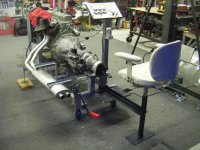Csarneson
Jedi Hopeful
Offline
I’m working my way through a 57 BN4 and have nearly finished rebuilding the engine. This is my first time for engine work. The rest of the car is several years away from being done. What’s the best way to store the engine?
1) pump oil up to the rockers (I built a pre-oiler), prime the oil pump, and then bag it up for a couple years?
or
2) build an engine test stand to fire it up and do a brief break in?
thanks!
Chris
1) pump oil up to the rockers (I built a pre-oiler), prime the oil pump, and then bag it up for a couple years?
or
2) build an engine test stand to fire it up and do a brief break in?
thanks!
Chris

 Hi Guest!
Hi Guest!

 smilie in place of the real @
smilie in place of the real @
 Pretty Please - add it to our Events forum(s) and add to the calendar! >>
Pretty Please - add it to our Events forum(s) and add to the calendar! >> 



